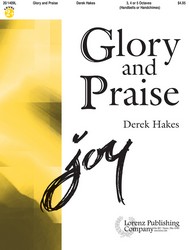Scripture References:
st. 1 = Deut. 32:3, Ps.148:13, Ps.145:11-13
st. 3 = Rev. 5:12-14, Rev. 7:10
The year this text was written, 1744, was a year of political and religious turmoil in Britain. The newly formed Methodist societies were suspected of being merely disguised Roman Catholic societies and were accused of attempting to overthrow the Crown. To strengthen and reassure his Methodist followers,
Charles Wesley (PHH 267) anonymously published Hymns for Times of Trouble and Persecution (1744). This text, in seventeen stanzas, was the first of the "Hymns to be Sung in a Tumult." Of those stanzas, 1 and 4-6 of Wesley's Part I are included; the battle-song stanzas, which the small but heroic Methodist groups sang in the face of violent opposition, are omitted.
The text is a hymn of thankful praise to Christ for his victorious reign and for providing salvation for his people. It reveals the cosmic scope of Christ's kingdom (st. I) and helps us to join our voices with the great doxology to Christ, the Lamb, as foretold in Revelation 5:9-14 (st. 24). In the first stanza "servants" refers to all Christians, not just clergy, to those made "to be a kingdom and priests to serve our God" (Rev. 5:10).
Liturgical Use:
A great doxology for festive services such as Easter; with eschatological preaching during Advent; other services that focus on Christ's work of redemption and his glory.
--Psalter Hymnal Handbook
=========================
Ye servants of God, Your Master proclaim. C. Wesley. [Missions.] Published in Hymns for Times of Trouble and Persecution, 1744, in 6 stanzas of 4 lines, as No. 1 of “Hymns to be sung in Tumult" (Poetical Works, 1868-72, vol. iv. p. 51). It is given in its full, or in an abbreviated form in several of the older collections, and especially those of the Church of England. In 1830 a cento was included in the Supplement of the Wesleyan Hymn Book, No. 557, stanzas i.-v. being from this hymn, and st. vi. from C. Wesley's Funeral Hymns, 1746, No. 6, st. v. In the revised edition of the Wesleyan Hymn Book, 1875, this last stanza was omitted.
--John Julian, Dictionary of Hymnology (1907)
Notes
Scripture References:
st. 1 = Deut. 32:3, Ps.148:13, Ps.145:11-13
st. 3 = Rev. 5:12-14, Rev. 7:10
The year this text was written, 1744, was a year of political and religious turmoil in Britain. The newly formed Methodist societies were suspected of being merely disguised Roman Catholic societies and were accused of attempting to overthrow the Crown. To strengthen and reassure his Methodist followers,
Charles Wesley (PHH 267) anonymously published Hymns for Times of Trouble and Persecution (1744). This text, in seventeen stanzas, was the first of the "Hymns to be Sung in a Tumult." Of those stanzas, 1 and 4-6 of Wesley's Part I are included; the battle-song stanzas, which the small but heroic Methodist groups sang in the face of violent opposition, are omitted.
The text is a hymn of thankful praise to Christ for his victorious reign and for providing salvation for his people. It reveals the cosmic scope of Christ's kingdom (st. I) and helps us to join our voices with the great doxology to Christ, the Lamb, as foretold in Revelation 5:9-14 (st. 24). In the first stanza "servants" refers to all Christians, not just clergy, to those made "to be a kingdom and priests to serve our God" (Rev. 5:10).
Liturgical Use:
A great doxology for festive services such as Easter; with eschatological preaching during Advent; other services that focus on Christ's work of redemption and his glory.
--Psalter Hymnal Handbook
=========================
Ye servants of God, Your Master proclaim. C. Wesley. [Missions.] Published in Hymns for Times of Trouble and Persecution, 1744, in 6 stanzas of 4 lines, as No. 1 of “Hymns to be sung in Tumult" (Poetical Works, 1868-72, vol. iv. p. 51). It is given in its full, or in an abbreviated form in several of the older collections, and especially those of the Church of England. In 1830 a cento was included in the Supplement of the Wesleyan Hymn Book, No. 557, stanzas i.-v. being from this hymn, and st. vi. from C. Wesley's Funeral Hymns, 1746, No. 6, st. v. In the revised edition of the Wesleyan Hymn Book, 1875, this last stanza was omitted.
--John Julian, Dictionary of Hymnology (1907)
Hymnary Pro Subscribers
Access
an additional article
on the Canterbury Dictionary of Hymnology:
Hymnary Pro subscribers have full access to the Canterbury Dictionary of Hymnology.
Subscribe now


 My Starred Hymns
My Starred Hymns








